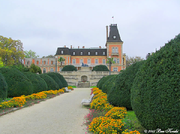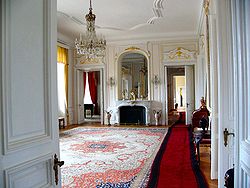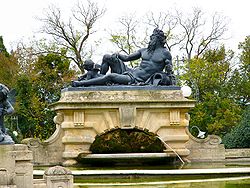
Euxinograd
Encyclopedia

Bulgaria
Bulgaria , officially the Republic of Bulgaria , is a parliamentary democracy within a unitary constitutional republic in Southeast Europe. The country borders Romania to the north, Serbia and Macedonia to the west, Greece and Turkey to the south, as well as the Black Sea to the east...
n royal summer palace and park on the Black Sea
Black Sea
The Black Sea is bounded by Europe, Anatolia and the Caucasus and is ultimately connected to the Atlantic Ocean via the Mediterranean and the Aegean seas and various straits. The Bosphorus strait connects it to the Sea of Marmara, and the strait of the Dardanelles connects that sea to the Aegean...
coast, 8 kilometres (5 mi) north of downtown Varna
Varna
Varna is the largest city and seaside resort on the Bulgarian Black Sea Coast and third-largest in Bulgaria after Sofia and Plovdiv, with a population of 334,870 inhabitants according to Census 2011...
. It is currently a governmental and presidential retreat hosting cabinet meetings in the summer and offering access for tourists to several villas and hotels. Since 2007, it is also the venue of the Operosa annual opera festival.
History

Knyaz
Kniaz, knyaz or knez is a Slavic title found in most Slavic languages, denoting a royal nobility rank. It is usually translated into English as either Prince or less commonly as Duke....
Alexander Battenberg
Alexander, Prince of Bulgaria
Alexander Joseph, Prince of Bulgaria GCB , known as Alexander of Battenberg, was the first prince of modern Bulgaria, reigning from 29 April 1879 to 7 September 1886.-Early life:...
as a present by the Greek
Greek Orthodox Church
The Greek Orthodox Church is the body of several churches within the larger communion of Eastern Orthodox Christianity sharing a common cultural tradition whose liturgy is also traditionally conducted in Koine Greek, the original language of the New Testament...
bishopric
Diocese
A diocese is the district or see under the supervision of a bishop. It is divided into parishes.An archdiocese is more significant than a diocese. An archdiocese is presided over by an archbishop whose see may have or had importance due to size or historical significance...
on 16 March 1882. There had previously been small monasteries called St. Demetrius and St. Constantine at that place, the buildings of which were subsequently converted into another small residence.
Viennese
Vienna
Vienna is the capital and largest city of the Republic of Austria and one of the nine states of Austria. Vienna is Austria's primary city, with a population of about 1.723 million , and is by far the largest city in Austria, as well as its cultural, economic, and political centre...
architect
Architect
An architect is a person trained in the planning, design and oversight of the construction of buildings. To practice architecture means to offer or render services in connection with the design and construction of a building, or group of buildings and the space within the site surrounding the...
Viktor Rumpelmayer
Viktor Rumpelmayer
Viktor Rumpelmayer was a 19th-century Austro-Hungarian architect, whose style was a combination of French and Italian influences and the Viennese trends characteristic for the period...
provided the original design for the palace. The palace was initially named Sandrovo in 1885 after the Italian
Italian language
Italian is a Romance language spoken mainly in Europe: Italy, Switzerland, San Marino, Vatican City, by minorities in Malta, Monaco, Croatia, Slovenia, France, Libya, Eritrea, and Somalia, and by immigrant communities in the Americas and Australia...
diminutive
Diminutive
In language structure, a diminutive, or diminutive form , is a formation of a word used to convey a slight degree of the root meaning, smallness of the object or quality named, encapsulation, intimacy, or endearment...
of Alexander's name — Sandro. Later the knyaz extended the estate to its contemporary area of 80 hectares (197.7 acre). However, no buildings were constructed at the time.
The palace was built during the rule of Knyaz (later Tsar
Tsar
Tsar is a title used to designate certain European Slavic monarchs or supreme rulers. As a system of government in the Tsardom of Russia and Russian Empire, it is known as Tsarist autocracy, or Tsarism...
) Ferdinand. The pediment and other materials from the right wing of Château de Saint-Cloud
Château de Saint-Cloud
The Château de Saint-Cloud was a Palace in France, built on a magnificent site overlooking the Seine at Saint-Cloud in Hauts-de-Seine, about 10 kilometres west of Paris. Today it is a large park on the outskirts of the capital and is owned by the state, but the area as a whole has had a large...
in France, a former royal residence, were brought to Bulgaria by Ferdinand and integrated in the Euxinograd palace. Ferdinand invited the Swiss
Switzerland
Switzerland name of one of the Swiss cantons. ; ; ; or ), in its full name the Swiss Confederation , is a federal republic consisting of 26 cantons, with Bern as the seat of the federal authorities. The country is situated in Western Europe,Or Central Europe depending on the definition....
architect Hermann Mayer and Bulgarian architect Nikola Lazarov to finish the design of the palace. It was renamed Euxinograd in 1893 on the insistence of Princess Marie Louise
Marie Louise of Bourbon-Parma
Princess Maria Luisa of Bourbon-Parma was the eldest daughter of Robert I, the last reigning Duke of Parma. She became princess-consort of Bulgaria upon her marriage to Ferdinand of Bulgaria, the then prince-regnant...
, Ferdinand's first wife. The name comes from the Ancient Greek
Ancient Greek
Ancient Greek is the stage of the Greek language in the periods spanning the times c. 9th–6th centuries BC, , c. 5th–4th centuries BC , and the c. 3rd century BC – 6th century AD of ancient Greece and the ancient world; being predated in the 2nd millennium BC by Mycenaean Greek...
term for the Black Sea
Black Sea
The Black Sea is bounded by Europe, Anatolia and the Caucasus and is ultimately connected to the Atlantic Ocean via the Mediterranean and the Aegean seas and various straits. The Bosphorus strait connects it to the Sea of Marmara, and the strait of the Dardanelles connects that sea to the Aegean...
, (Euxeinos Pontos, "hospitable sea") and the South Slavic
South Slavic languages
The South Slavic languages comprise one of three branches of the Slavic languages. There are approximately 30 million speakers, mainly in the Balkans. These are separated geographically from speakers of the other two Slavic branches by a belt of German, Hungarian and Romanian speakers...
suffix –grad, meaning "town" or, historically, "fortress".
Tsar Ferdinand's second wife, Tsaritsa
Tsaritsa
Tsaritsa , formerly spelled czaritsa , is the title of a female autocratic ruler of Bulgaria or Russia, or the title of a tsar's wife....
Eleonore
Eleonore, Princess Reuss-Köstritz
Princess Eleonore Caroline Gasparine Louise Reuss of Köstritz was Tsaritsa of Bulgaria and the second wife of Tsar Ferdinand of Bulgaria...
, died in Euxinograd on 12 September 1917.
After the abolition of the monarchy in Bulgaria, following a referendum held under the auspices of the Communists in 1946, Euxinograd became a summer residence of the then-Communist authorities. The democratic changes in 1989 made the former royal palace a presidential and governmental residence and opened it for the public.
Buildings
Modelled after the FrenchFrance
The French Republic , The French Republic , The French Republic , (commonly known as France , is a unitary semi-presidential republic in Western Europe with several overseas territories and islands located on other continents and in the Indian, Pacific, and Atlantic oceans. Metropolitan France...
Château de Saint-Cloud
Château de Saint-Cloud
The Château de Saint-Cloud was a Palace in France, built on a magnificent site overlooking the Seine at Saint-Cloud in Hauts-de-Seine, about 10 kilometres west of Paris. Today it is a large park on the outskirts of the capital and is owned by the state, but the area as a whole has had a large...
, Euxinograd is often considered to be one of the finest examples of post-Liberation
Liberation of Bulgaria
In Bulgarian historiography, the term Liberation of Bulgaria is used to denote the events of the Russo-Turkish War of 1877-78 that led to the re-establishment of Bulgarian state with the Treaty of San Stefano of March 3, 1878, after the complete conquest of the Second Bulgarian Empire, which...
architecture in Bulgaria. After the French château was destroyed during the Franco-Prussian War
Franco-Prussian War
The Franco-Prussian War or Franco-German War, often referred to in France as the 1870 War was a conflict between the Second French Empire and the Kingdom of Prussia. Prussia was aided by the North German Confederation, of which it was a member, and the South German states of Baden, Württemberg and...
in 1870, Ferdinand acquired the pediment
Pediment
A pediment is a classical architectural element consisting of the triangular section found above the horizontal structure , typically supported by columns. The gable end of the pediment is surrounded by the cornice moulding...
of its right wing for Euxinograd palace in 1890–1891. The palace was modelled after the French 18th-century château style, with a high metal-edged French-style mansard roof
Mansard roof
A mansard or mansard roof is a four-sided gambrel-style hip roof characterized by two slopes on each of its sides with the lower slope at a steeper angle than the upper that is punctured by dormer windows. The roof creates an additional floor of habitable space, such as a garret...
, figured brickwork and a clock tower
Clock tower
A clock tower is a tower specifically built with one or more clock faces. Clock towers can be either freestanding or part of a church or municipal building such as a town hall. Some clock towers are not true clock towers having had their clock faces added to an already existing building...
.

Mahogany
The name mahogany is used when referring to numerous varieties of dark-colored hardwood. It is a native American word originally used for the wood of the species Swietenia mahagoni, known as West Indian or Cuban mahogany....
and walnut
Walnut
Juglans is a plant genus of the family Juglandaceae, the seeds of which are known as walnuts. They are deciduous trees, 10–40 meters tall , with pinnate leaves 200–900 millimetres long , with 5–25 leaflets; the shoots have chambered pith, a character shared with the wingnuts , but not the hickories...
wood. The giant chandelier decorated with a royal crown and gold lilies is a gift from the House of Bourbon
House of Bourbon
The House of Bourbon is a European royal house, a branch of the Capetian dynasty . Bourbon kings first ruled Navarre and France in the 16th century. By the 18th century, members of the Bourbon dynasty also held thrones in Spain, Naples, Sicily, and Parma...
. The doorhandles of the toilets bear the coat of arms of Tsar Ferdinand. The sundial
Sundial
A sundial is a device that measures time by the position of the Sun. In common designs such as the horizontal sundial, the sun casts a shadow from its style onto a surface marked with lines indicating the hours of the day. The style is the time-telling edge of the gnomon, often a thin rod or a...
, a gift from Queen Victoria
Victoria of the United Kingdom
Victoria was the monarch of the United Kingdom of Great Britain and Ireland from 20 June 1837 until her death. From 1 May 1876, she used the additional title of Empress of India....
, is another object of interest.
The palace's wine cellar
Wine cellar
A wine cellar is a storage room for wine in bottles or barrels, or more rarely in carboys, amphorae or plastic containers. In an active wine cellar, important factors such as temperature and humidity are maintained by a climate control system. In contrast, passive wine cellars are not...
was established in 1891 for the needs of the Bulgarian Royal Family and takes up two underground floors. It still produces high-quality white wine (twelve varieties) and brandy (seven varieties). The wine produced in the palace nowadays is thought of as one of the best in Bulgaria. The Euxinograd cellar has been preserving valuable 125-year-old French wines since the Liberation of Bulgaria. In addition, the Euxinograd complex also includes a former royal stable called Shtala (Щала; from German
German language
German is a West Germanic language, related to and classified alongside English and Dutch. With an estimated 90 – 98 million native speakers, German is one of the world's major languages and is the most widely-spoken first language in the European Union....
Stall).
Park
The Euxinograd park, the arrangement of which began in 1890 and took several decades, is home to over 310 plant varieties from AsiaAsia
Asia is the world's largest and most populous continent, located primarily in the eastern and northern hemispheres. It covers 8.7% of the Earth's total surface area and with approximately 3.879 billion people, it hosts 60% of the world's current human population...
, South America
South America
South America is a continent situated in the Western Hemisphere, mostly in the Southern Hemisphere, with a relatively small portion in the Northern Hemisphere. The continent is also considered a subcontinent of the Americas. It is bordered on the west by the Pacific Ocean and on the north and east...
, North Africa
North Africa
North Africa or Northern Africa is the northernmost region of the African continent, linked by the Sahara to Sub-Saharan Africa. Geopolitically, the United Nations definition of Northern Africa includes eight countries or territories; Algeria, Egypt, Libya, Morocco, South Sudan, Sudan, Tunisia, and...
and Southern France
Southern France
Southern France , colloquially known as le Midi is defined geographical area consisting of the regions of France that border the Atlantic Ocean south of the Gironde, Spain, the Mediterranean, and Italy...
, said to be picked out by Ferdinand himself. It occupies an area of over 550 decare. The park is a combination of both the English and French landscaping styles, English garden
English garden
The English garden, also called English landscape park , is a style of Landscape garden which emerged in England in the early 18th century, and spread across Europe, replacing the more formal, symmetrical Garden à la française of the 17th century as the principal gardening style of Europe. The...
and garden à la française
Garden à la française
The French formal garden, also called jardin à la française, is a style of garden based on symmetry and the principle of imposing order over nature. It reached its apogee in the 17th century with the creation of the Gardens of Versailles, designed for Louis XIV by the landscape architect André Le...
, and was mostly designed by Édouard André
Édouard André
Édouard François André was a French horticulturalist, landscape designer, as well as a leading landscape architect of the late 19th century, famous for designing city parks and public spaces of Monte Carlo and Montevideo....
. It has two bridges, a metal one and a cement one, which imitates a fallen tree. The area is surrounded by vineyards.
The tiny Kestrichka Bara River flows through the park. The park also features a small lake full of lilies, French-made bronze figures and a sculpture of Neptune. More than 50,000 trees were purchased from Marseille
Marseille
Marseille , known in antiquity as Massalia , is the second largest city in France, after Paris, with a population of 852,395 within its administrative limits on a land area of . The urban area of Marseille extends beyond the city limits with a population of over 1,420,000 on an area of...
and fertile soil was brought from the mouth of the Kamchiya River.
See also
- Royal Palace in SofiaNational Art Gallery (Bulgaria)The National Art Gallery is Bulgaria's national gallery and houses over 50,000 pieces of Bulgarian art. It is located on Battenberg Square in the capital city of Sofia, occupying most of the historic and imposing edifice of the former royal palace of Bulgaria, having been established in 1934 and...
- Vrana PalaceVrana PalaceVrana Palace is a former royal palace, located on the outskirts of Sofia, the capital of Bulgaria. It is today the official residence of the deposed Tsar Simeon II of Bulgaria and his wife Tsaritsa Margarita...
- Tsarska BistritsaTsarska BistritsaTsarska Bistritsa is a former royal palace in southwestern Bulgaria, high in the Rila Mountains, just above the resort of Borovets and near the banks of the Bistritsa River...
- MassandraMassandraMassandra is a townlet in the Yalta region of Crimea. Occupying the spot of an ancient Greek settlement, Massandra was acquired by Counts Potocki in 1783....
in CrimeaCrimeaCrimea , or the Autonomous Republic of Crimea , is a sub-national unit, an autonomous republic, of Ukraine. It is located on the northern coast of the Black Sea, occupying a peninsula of the same name...
— the site of a similar seaside château, commissioned by Alexander III of RussiaAlexander III of RussiaAlexander Alexandrovich Romanov , historically remembered as Alexander III or Alexander the Peacemaker reigned as Emperor of Russia from until his death on .-Disposition:...
External links
- Pictures and History (in BulgarianBulgarian languageBulgarian is an Indo-European language, a member of the Slavic linguistic group.Bulgarian, along with the closely related Macedonian language, demonstrates several linguistic characteristics that set it apart from all other Slavic languages such as the elimination of case declension, the...
) - Euxinograd
- Official website

